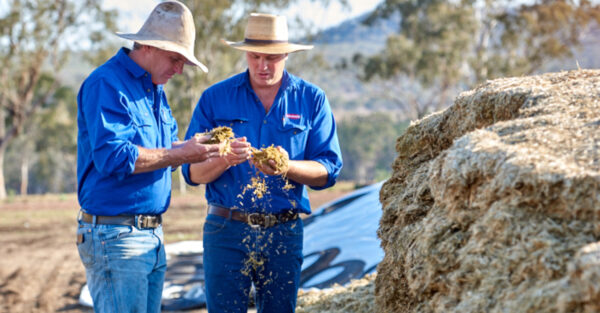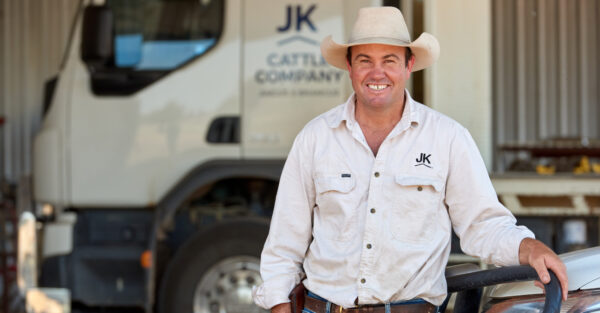Blog | Reading Time 4 minutes
Silage proves to be a good investment
Three years ago, Ballaroo district mixed farmer, Sarah Packer, took advantage of the opportunity to purchase 1000 tonnes of sorghum silage from a neighbour even though she had an abundance of green feed at the time.
Fast forward to the recent dry conditions gripping parts of the Maranoa region, she is feeding a source of quality forage, allowing her to keep her breeding nucleus intact.
Sarah runs 450 Santa x Charolais cows and replacement heifers, 1200 Dorper ewes and 1000 rangeland goats on ‘Hartwood’, a 8000 ha property located about 80 km south of Roma.
Cattle are sold as 230 to 260 kg weaners or if the season allows, grown out to 360 to 400 kg for the domestic or feedlot markets.
In 2021, Sarah made the brave decision to pour $100,000 of hard-earned cash into silage.
“At the time, we had green feed up to our knees but we also know there are times when we have no alternative to supplementary feeding,” she says.
“A neighbour contacted me and asked if I wanted to buy some forage sorghum.
“I had absolutely no experience in silage but I thought this was too good an opportunity to pass up.
“Initially, the plan was to bury it but then we decided to make a stack instead because it would be easier to handle and cleaner.
“We prepared a pad, fenced it off and put a levee bank around it to avoid water entering the site.”
Initially the stack was covered and sealed with conventional black and white silage film however upon consultation with Lallemand Technical Service Manager, Nathan Lister, it was decided that the initial sealing system was not going to be sufficient enough for the long-term storage that was desired.
So the original stack was bolstered with Silostop Max and SilageKeeper UV Covers which provided a protective barrier from wildlife and the environment. A two-step system which will ensure an optimum feeding outcome.
Sarah opened the stack in spring 2023 and is impressed by the quality.
“My intention was to put it away for 5–10 years but here we are just three years later,” she says.
“We’ve had barely 100 mm of rain in the past 12 months instead of the 600 mm average.”
Sarah is now busy feeding the silage to earlyweaned lambs in the yards and first and second-calf cows in the paddocks.
The lamb ration also contains barley grain and a protein supplement including vitamins and minerals.
“We just want to keep our livestock and get them sold.
“The real benefit for me will be being able to early wean our calves if the season doesn’t improve and supplementary feed them to keep them going.
“We will grow them out to 220 kg and make the call of whether to sell them, keep feeding them or put them back in the mulga.”
Sarah says her investment in silage has more than paid for itself.
“At approximately $100/tonne, this is cheap insurance,” she says.
“It’s a quality feed and it’s way cheaper than hay.
“If you have to feed out in a dry time, the benefit of having silage is you’re not trying to purchase feed at the same time as everyone else.
“It’s been an absolute game changer – 200%!
“If I hadn’t purchased this silage three years ago, I wouldn’t have any livestock now.
“I will definitely do this again, possibly growing our own sorghum.”
Sarah has also invested about $50,000 in a Celikel Brassus H8 horizontal mixer wagon and a $75,000 for a late model CASE IH Farmall 110JX tractor.
“Buying a wagon and a tractor has been a good investment in quality and time,” she says.
“Before we were just bucketing the silage out in the paddock, which is a bit of a waste of both time and money.”
Sarah started buying ‘Hartwood’ one paddock at time from her parents in 2016.
“I had the opportunity to come home but I still needed an off-farm job to provide cash flow,” she says.
“An opportunity came up to work with a livestock agency and I grabbed it.”
Sarah became the first woman to compete in the Queensland Young Auctioneers Competition and then the first female auctioneer in Australia to sell stud stock.
She has since returned to work full-time on ‘Hartwood’, with a bit of work as a rebate livestock agent in Roma and surrounding areas.
‘Hartwood’ has a range of red mulga country for breeding and alluvial flats and black soils for cropping.
Up to 800 ha is arable, but Sarah is letting much of it revert to buffel pastures, along with deep ripping to control regrowth and improve water retention.
“This is a very diverse block,” she says.
“Mum and Dad ran mostly cattle but I could see the opportunity to utilise the country to its full advantage by introducing sheep and goats.”
Published Apr 16, 2024
Related articles
Need specific information?
Talk to an expert


